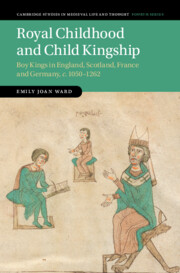Book contents
- Royal Childhood and Child Kingship
- Cambridge Studies in Medieval Life and Thought
- Royal Childhood and Child Kingship
- Copyright page
- Dedication
- Contents
- Figures
- Preface and Acknowledgements
- Abbreviations
- Genealogies
- Chapter 1 Royal Childhood and Child Kingship
- Part I Royal Childhood and Child Kingship: Models and History
- Chapter 2 Children and Kingship in the Early and Central Middle Ages
- Chapter 3 Woe to Thee, O Land? Models of Child Kingship
- Part II Royal Childhood: Preparation for the Throne
- Part III Child Kingship: Guardianship and Royal Rule
- Bibliography
- Index
Chapter 3 - Woe to Thee, O Land? Models of Child Kingship
from Part I - Royal Childhood and Child Kingship: Models and History
Published online by Cambridge University Press: 04 August 2022
- Royal Childhood and Child Kingship
- Cambridge Studies in Medieval Life and Thought
- Royal Childhood and Child Kingship
- Copyright page
- Dedication
- Contents
- Figures
- Preface and Acknowledgements
- Abbreviations
- Genealogies
- Chapter 1 Royal Childhood and Child Kingship
- Part I Royal Childhood and Child Kingship: Models and History
- Chapter 2 Children and Kingship in the Early and Central Middle Ages
- Chapter 3 Woe to Thee, O Land? Models of Child Kingship
- Part II Royal Childhood: Preparation for the Throne
- Part III Child Kingship: Guardianship and Royal Rule
- Bibliography
- Index
Summary
Artists and writers placed the figure of a boy king centrally, using images and stories of historical and biblical child rulers as exempla. This chapter focuses on narrative and artistic traditions of models of child kingship to illustrate the positive cultural associations between childhood and kingship. Scholars have almost exclusively assessed cultural representations of rulership from the perspective of an adult king. But authors used a parallel range of models to contextualise and legitimise a boy’s succession and rule. The chapter looks first at Old Testament kings such as Jehoash and Josiah, then turns to representations of the humble child David, which were especially prominent in coronation ordines and psalter illuminations. Growing interest in Latin, vernacular and visual depictions of Jesus’s childhood is considered in the third section. Interrogating the circulation of these positive biblical models challenges the dominant narrative linking child kingship with disruption and political disorder. The chapter’s final section therefore turns a more rigorous spotlight on the oft-cited Ecclesiastes 10:16 verse which warned that a boy king would bring ‘woe to the land’.
Keywords
- Type
- Chapter
- Information
- Royal Childhood and Child KingshipBoy Kings in England, Scotland, France and Germany, c. 1050–1262, pp. 53 - 82Publisher: Cambridge University PressPrint publication year: 2022

